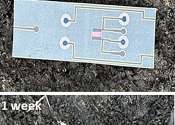Using thermotropic liquid crystals to enhance the efficiency and stability of perovskite solar modules
Solar panels and photovoltaics (PVs) are becoming increasingly widespread, contributing to ongoing efforts aimed at decarbonizing electricity production. Solar cells based on perovskites, a class of minerals that can leverage ...









